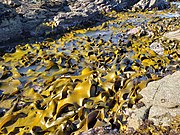bio.wikisort.org - Plant
Durvillaea poha is a large, robust species of southern bull kelp found in New Zealand.[1][2][3]
| Durvillaea poha | |
|---|---|
 | |
| Durvillaea poha in foreground (with D. willana below) at Brighton Beach, Otago | |
| Scientific classification | |
| Clade: | SAR |
| Phylum: | Ochrophyta |
| Class: | Phaeophyceae |
| Order: | Fucales |
| Family: | Durvillaeaceae |
| Genus: | Durvillaea |
| Species: | D. poha |
| Binomial name | |
| Durvillaea poha C.I. Fraser, H.G. Spencer & J.M. Waters, 2012 | |
Discovery
The species was previously classified as the "cape" lineage of Durvillaea antarctica,[4][5] but in 2012 it was recognised as a distinct species due to consistent genetic, morphological and ecological differences.[1] In southern New Zealand, D. poha and D. antarctica frequently grow next to one another, although D. poha normally grows higher up or further back on rock platforms, or in more sheltered bays, where wave force is weaker.[1][6] D. poha generally has wider fronds than D. antarctica, and can appear more 'orange' across the frond area.[1][2] Mitochondrial introgression has been observed between the two species, where some plants in Wellington exhibited the nuclear DNA of D. poha but also mitochondrial DNA belonging to D. antarctica.[3]
Etymology
The specific epithet is from pōhā, storage bags made by Māori out of kelp fronds.[7][8]
Description
The species has wide, air filled blades with a 'honeycomb' structure, and relative stout, pale or orange stipes. The stipes are unbranched.[1][2]
Distribution
The species is endemic to New Zealand, and is predominantly found along southern coasts of the South Island and on Stewart Island, as well as on the subantarctic Snares and Auckland Islands.[1][3][4][6] Based on genetic data, the species appears to have undergone a recent range expansion into the North Island, as it can be found at low frequencies along the Wellington coastline.[3] This range expansion coincides with areas affected by tectonic uplift and landslides caused by historic earthquakes, including the 1855 Wairarapa earthquake.[3] The removal of D. antarctica and formation of new coastline by such tectonic disturbance likely provided an ecological opportunity for D. poha to successfully colonise coastline north of the Cook Strait.[3]
Human use
Māori culture

Along with D. antarctica, blades of D. poha are used to make traditional pōhā bags, which are used to carry and store food and fresh water, to propagate live shellfish, and to make clothing and equipment for sports.[7][8][9] Pōhā bags are especially associated with the Ngāi Tahu people, and are often used to carry and store muttonbird (tītī) chicks.[7][8]
References
- Fraser, Ceridwen I.; Spencer, Hamish G.; Waters, Jonathan M. (2012). "Durvillaea poha sp. nov. (Fucales, Phaeophyceae): a buoyant southern bull-kelp species endemic to New Zealand". Phycologia. 51 (2): 151–156. doi:10.2216/11-47.1. S2CID 86386681.
- Fraser, Ceridwen I.; Velásquez, Marcel; Nelson, Wendy A.; Macaya, Erasmo C.A.; Hay, Cameron (2019). "The biogeographic importance of buoyancy in macroalgae: a case study of the southern bull‐kelp genus Durvillaea (Phaeophyceae), including descriptions of two new species". Journal of Phycology. 56 (1): 23–36. doi:10.1111/jpy.12939. PMID 31642057.
- Vaux, Felix; Craw, Dave; Fraser, Ceridwen I.; Waters, Jonathan M. (2021). "Northward range extension for Durvillaea poha bull kelp: Response to tectonic disturbance?". Journal of Phycology. 57 (5): 1411–1418. doi:10.1111/jpy.13179. PMID 33942304.
- Fraser, Ceridwen I.; Hay, Cameron H.; Spencer, Hamish G.; Waters, Jonathan M. (2009). "Genetic and morphological analyses of the southern bull kelp Durvillaea antarctica (Phaeophyceae: Durvillaeales) in New Zealand reveal cryptic species". Journal of Phycology. 45 (2): 436–443. doi:10.1111/j.1529-8817.2009.00658.x. PMID 27033822. S2CID 18309093.
- Fraser, C.I.; Winter, D.J.; Spencer, H.G.; Waters, J.M. (2010). "Multigene phylogeny of the southern bull-kelp genus Durvillaea (Phaeophyceae: Fucales)". Molecular Phylogenetics and Evolution. 57 (3): 1301–11. doi:10.1016/j.ympev.2010.10.011. PMID 20971197.
- Parvizi, Elahe; Fraser, Ceridwen I.; Dutoit, Ludovic; Craw, Dave; Waters, Jonathan M. (2020). "The genomic footprint of coastal earthquake uplift". Proceedings of the Royal Society B. 287 (1930): 20200712. doi:10.1098/rspb.2020.0712. PMC 7423469. PMID 32635859.
- "Page 4. Traditional use of seaweeds". Te Ara: The Encyclopedia of New Zealand. 12 June 2006. Retrieved 19 November 2019.
- "Traditional Māori food gathering". Museum of New Zealand Te Papa Tongarewa. 30 May 2016. Retrieved 21 November 2019.
- "Maori shellfish project wins scholarship". SunLive. 13 May 2018. Retrieved 26 November 2019.
External links
- Algaebase: Durvillaea poha C.I.Fraser, H.G.Spencer & J.M.Waters
- Museum of New Zealand Te Papa Tongarewa: Durvillaea poha C.I.Fraser & J.M.Waters (Species)
Другой контент может иметь иную лицензию. Перед использованием материалов сайта WikiSort.org внимательно изучите правила лицензирования конкретных элементов наполнения сайта.
WikiSort.org - проект по пересортировке и дополнению контента Википедии


